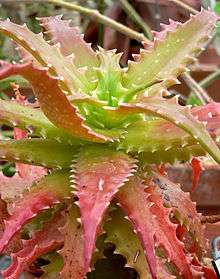Aloe dorotheae
Aloe dorotheae is a critically endangered succulent plant in the genus Aloe, native to Tanzania.
| Aloe dorotheae | |
|---|---|
 | |
| Scientific classification | |
| Kingdom: | Plantae |
| Clade: | Tracheophytes |
| Clade: | Angiosperms |
| Clade: | Monocots |
| Order: | Asparagales |
| Family: | Asphodelaceae |
| Subfamily: | Asphodeloideae |
| Genus: | Aloe |
| Species: | A. dorotheae |
| Binomial name | |
| Aloe dorotheae A.Berger | |
Description
Its leaves are recurved, spotted, and have a glossy surface. They turn a strong reddish colour during times of drought or under stressed, exposed conditions. The stems are sprawling and decumbent, and it can eventually form large clumps.
Distribution and habitat
The species has a very restricted distribution in the wild, limited to only two localities consisting of rocky outcrops in the Eastern Arc Mountains of Tanzania, but is common and popular as an ornamental in cultivation. It requires well-drained soil, some exposure to sun, and it prefers a summer-rainfall watering regime.[1]
It is one of 16 aloe species which are endemic to Tanzania, and one of a further 26 Aloe species which are indigenous (but not endemic) to that country.[note 1][2]
Conservation
A. dortheae is classified as Critically Endangered by the IUCN based on its extremely limited distribution, which overlaps with a heavily populated district. It is likely being collected for medicinal purposes.[1]
| Wikimedia Commons has media related to Aloe dorotheae. |
Notes
- Note:
Tanzania Aloe endemics: A. babatiensis, boscawenii, brachystachys, brandhamii, bukobana, bullockii, bussei, congdonii, dorotheae, flexilifolia, leachii, leedalii, leptosiphon, massawana, pembana, richardsiae.
Tanzania Aloe indigenous: A. parvidens; lateritia; secundiflora; rabaiensis; volkensii; wollastonii; macrosiphon; ballyi, confusa, deserti, elata, fibrosa, morijensis, ngongensis; bicomitum, fimbrialis, veseyi; duckeri; mzimbana; bulbicaulis, nuttii; christianii; mawii; chabaudii; myriacantha
References
- Eastern Arc Mountains & Coastal Forests CEPF Plant Assessment Project Participants (2009). "Aloe dorotheae". IUCN Red List of Threatened Species. 2009: e.T158335A5195945. doi:10.2305/IUCN.UK.2009-2.RLTS.T158335A5195945.en.
- "Aloe dorotheae - Aloe". Biodiversity Warriors.
